Deja Vu
"Are you still in love with it all?" - Young Galaxy, 'Come and See'
Friday, February 01, 2013
Friday, December 02, 2011
Monday, May 02, 2011
Friday, April 01, 2011
Tuesday, March 15, 2011
Friday, February 11, 2011
When I watch people I get a tingly sensation in my head?!? | Is It Normal? | http://isitnormal.com
Everytime the cleaning lady comes to my office, why?
Tuesday, February 08, 2011
Crazy Japanese Thing of the Day: Japan’s Sushi Candy: And you thought Lunchables required a lot of prep-work.
[reddit.]
Tuesday, January 11, 2011
Sunday, January 09, 2011
6 Professions Deader Than Print Journalism
Bonus: For some reason I find this the funniest of all the Courage Wolf pics. This is Baby Courage Wolf.

Friday, December 31, 2010
Friday, December 10, 2010
Saturday, November 13, 2010
Afternoon Snack: Hipster Leaves. Also: I’m posting this on...
Also: I’m posting this on...: "
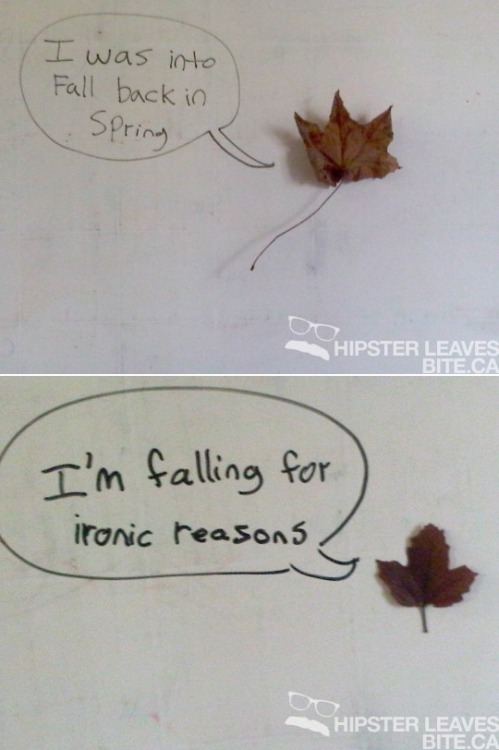
Afternoon Snack: Hipster Leaves.
Also: I’m posting this on Tumblr!!!
[bite.]
(412): Why are there maracas in...
Friday, November 12, 2010
Sunday, October 03, 2010

(330): just found a carrot inside...: "(330): just found a carrot inside of a baby sock. living with toddlers is like living with tiny hammered people.
Monday, September 20, 2010
Satellite Imagery of the Day: Burning Man 2010 as seen from the...
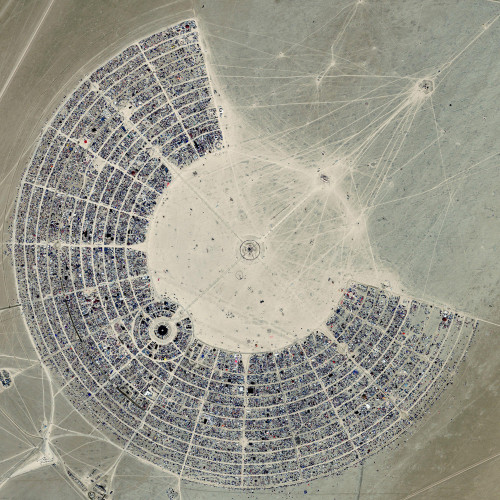
Satellite Imagery of the Day: Burning Man 2010 as seen from the vantage point of the GeoEye-1 satellite.
[kfmw.]
Saturday, September 04, 2010
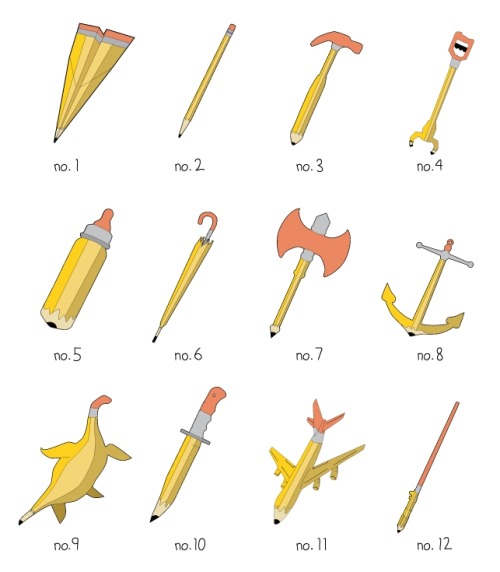
Nathan Pyle: “The Other Numbers”
I’m going to need several of these to go into production ASAP.
[superpunch.]
 Gummi bears? Gummi worms? Why limit yourself to such pedestrian gummi-shapes when you could make your own shapes in whatever gummi-sharks-with-laser-beams fashion you'd like.
Gummi bears? Gummi worms? Why limit yourself to such pedestrian gummi-shapes when you could make your own shapes in whatever gummi-sharks-with-laser-beams fashion you'd like.Craft-centric blog Skip to My Lou details how to make homemade gummi candies. The process is simple—about as simple as making Jell-o—and requires gelatin, Jell-o for flavoring, and a mold to shape your creations.
You could limit yourself to using store bought candy and cookie molds, but you'll never realize your dream of having an army of gummi Storm Troopers that way. Check out this tutorial about making gummi Lego blocks—the technique he uses to make molds for the Lego blocks could easily be adapted to make molds for anything your heart desires to see in delicious gummi-glory.
Written by Dan Koeppel Illustrations by Nanospore
You’re six miles up, alone and falling without a parachute. Though the odds are long, a small number of people have found themselves in similar situations—and lived to tell the tale. Here’s PM’s 120-mph, 35,000-ft, 3-minutes-to-impact survival guide.
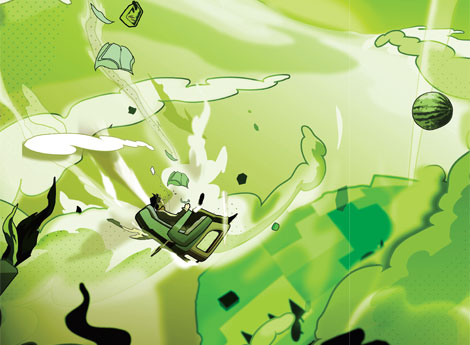
6:59:00 AM
35,000 Feet
You have a late night and an early flight. Not long after takeoff, you drift to sleep. Suddenly, you’re wide awake. There’s cold air rushing everywhere, and sound. Intense, horrible sound. Where am I?, you think. Where’s the plane?
You’re 6 miles up. You’re alone. You’re falling.
Things are bad. But now’s the time to focus on the good news.
(Yes, it goes beyond surviving the destruction of your aircraft.) Although gravity is against you, another force is working in your favor: time. Believe it or not, you’re better off up here than if you’d slipped from the balcony of your high-rise hotel room after one too many drinks last night.
Or at least you will be. Oxygen is scarce at these heights. By now, hypoxia is starting to set in. You’ll be unconscious soon, and you’ll cannonball at least a mile before waking up again. When that happens, remember what you are about to read. The ground, after all, is your next destination.
Granted, the odds of surviving a 6-mile plummet are extraordinarily slim, but at this point you’ve got nothing to lose by understanding your situation. There are two ways to fall out of a plane. The first is to free-fall, or drop from the sky with absolutely no protection or means of slowing your descent. The second is to become a wreckage rider, a term coined by Massachusetts-based amateur historian Jim Hamilton, who developed the Free Fall Research Page—an online database of nearly every imaginable human plummet. That classification means you have the advantage of being attached to a chunk of the plane. In 1972, Serbian flight attendant Vesna Vulovic was traveling in a DC-9 over Czechoslovakia when it blew up. She fell 33,000 feet, wedged between her seat, a catering trolley, a section of aircraft and the body of another crew member, landing on—then sliding down—a snowy incline before coming to a stop, severely injured but alive.
Surviving a plunge surrounded by a semiprotective cocoon of debris is more common than surviving a pure free-fall, according to Hamilton’s statistics; 31 such confirmed or “plausible” incidents have occurred since the 1940s. Free-fallers constitute a much more exclusive club, with just 13 confirmed or plausible incidents, including perennial Ripley’s Believe It or Not superstar Alan Magee—blown from his B-17 on a 1943 mission over France. The New Jersey airman, more recently the subject of a MythBusters episode, fell 20,000 feet and crashed into a train station; he was subsequently captured by German troops, who were astonished at his survival.
Whether you’re attached to crumpled fuselage or just plain falling, the concept you’ll be most interested in is terminal velocity. As gravity pulls you toward earth, you go faster. But like any moving object, you create drag—more as your speed increases. When downward force equals upward resistance, acceleration stops. You max out.
Depending on your size and weight, and factors such as air density, your speed at that moment will be about 120 mph—and you’ll get there after a surprisingly brief bit of falling: just 1500 feet, about the same height as Chicago’s Sears (now Willis) Tower. Equal speed means you hit the ground with equal force. The difference is the clock. Body meets Windy City sidewalk in 12 seconds. From an airplane’s cruising altitude, you’ll have almost enough time to read this entire article.
7:00:20 AM
22,000 Feet
By now, you’ve descended into breathable air. You sputter into consciousness. At this altitude, you’ve got roughly 2 minutes until impact. Your plan is simple. You will enter a Zen state and decide to live. You will understand, as Hamilton notes, “that it isn’t the fall that kills you—it’s the landing.”
Keeping your wits about you, you take aim.
But at what? Magee’s landing on the stone floor of that French train station was softened by the skylight he crashed through a moment earlier. Glass hurts, but it gives. So does grass. Haystacks and bushes have cushioned surprised-to-be-alive free-fallers. Trees aren’t bad, though they tend to skewer. Snow? Absolutely. Swamps? With their mucky, plant-covered surface, even more awesome. Hamilton documents one case of a sky diver who, upon total parachute failure, was saved by bouncing off high-tension wires. Contrary to popular belief, water is an awful choice. Like concrete, liquid doesn’t compress. Hitting the ocean is essentially the same as colliding with a sidewalk, Hamilton explains, except that pavement (perhaps unfortunately) won’t “open up and swallow your shattered body.”
With a target in mind, the next consideration is body position. To slow your descent, emulate a sky diver. Spread your arms and legs, present your chest to the ground, and arch your back and head upward. This adds friction and helps you maneuver. But don’t relax. This is not your landing pose.
The question of how to achieve ground contact remains, regrettably, given your predicament, a subject of debate. A 1942 study in the journal War Medicine noted “distribution and compensation of pressure play large parts in the defeat of injury.” Recommendation: wide-body impact. But a 1963 report by the Federal Aviation Agency argued that shifting into the classic sky diver’s landing stance—feet together, heels up, flexed knees and hips—best increases survivability. The same study noted that training in wrestling and acrobatics would help people survive falls. Martial arts were deemed especially useful for hard-surface impacts: “A ‘black belt’ expert can reportedly crack solid wood with a single blow,” the authors wrote, speculating that such skills might be transferable.
The ultimate learn-by-doing experience might be a lesson from Japanese parachutist Yasuhiro Kubo, who holds the world record in the activity’s banzai category. The sky diver tosses his chute from the plane and then jumps out after it, waiting as long as possible to retrieve it, put it on and pull the ripcord. In 2000, Kubo—starting from 9842 feet—fell for 50 seconds before recovering his gear. A safer way to practice your technique would be at one of the wind-tunnel simulators found at about a dozen U.S. theme parks and malls. But neither will help with the toughest part: sticking the landing. For that you might consider—though it’s not exactly advisable—a leap off the world’s highest bridge, France’s Millau Viaduct; its platform towers 891 feet over mostly spongy farmland.
Water landings—if you must—require quick decision-making. Studies of bridge-jump survivors indicate that a feet-first, knife-like entry (aka “the pencil”) best optimizes your odds of resurfacing. The famed cliff divers of Acapulco, however, tend to assume a head-down position, with the fingers of each hand locked together, arms outstretched, protecting the head. Whichever you choose, first assume the free-fall position for as long as you can. Then, if a feet-first entry is inevitable, the most important piece of advice, for reasons both unmentionable and easily understood, is to clench your butt.
No matter the surface, definitely don’t land on your head. In a 1977 “Study of Impact Tolerance Through Free-Fall Investigations,” researchers at the Highway Safety Research Institute found that the major cause of death in falls—they examined drops from buildings, bridges and the occasional elevator shaft (oops!)—was cranial contact. If you have to arrive top-down, sacrifice your good looks and land on your face, rather than the back or top of your head. You might also consider flying with a pair of goggles in your pocket, Hamilton says, since you’re likely to get watery eyes—impairing accuracy—on the way down. v

7:02:19 AM
1000 Feet
Given your starting altitude, you’ll be just about ready to hit the ground as you reach this section of instruction (based on the average adult reading speed of 250 words per minute). The basics have been covered, so feel free to concentrate on the task at hand. But if you’re so inclined, here’s some supplemental information—though be warned that none of it will help you much at this point.
Statistically speaking, it’s best to be a flight crew member, a child, or traveling in a military aircraft. Over the past four decades, there have been at least a dozen commercial airline crashes with just one survivor. Of those documented, four of the survivors were crew, like the flight attendant Vulovic, and seven were passengers under the age of 18. That includes Mohammed el-Fateh Osman, a 2-year-old wreckage rider who lived through the crash of a Boeing jet in Sudan in 2003, and, more recently, 14-year-old Bahia Bakari, the sole survivor of last June’s Yemenia Airways plunge off the Comoros Islands.
Crew survival may be related to better restraint systems, but there’s no consensus on why children seem to pull through falls more often. The Federal Aviation Agency study notes that kids, especially those under the age of 4, have more flexible skeletons, more relaxed muscle tonus, and a higher proportion of subcutaneous fat, which helps protect internal organs. Smaller people—whose heads are lower than the seat backs in front of them—are better shielded from debris in a plane that’s coming apart. Lower body weight reduces terminal velocity, plus reduced surface area decreases the chance of impalement upon landing.
7:02:25 am
0 Feet
The ground. Like a Shaolin master, you are at peace and prepared. Impact. You’re alive. What next? If you’re lucky, you might find that your injuries are minor, stand up and smoke a celebratory cigarette, as British tail gunner Nicholas Alkemade did in 1944 after landing in snowy bushes following an 18,000-foot plummet. (If you’re a smoker, you’re super extra lucky, since you’ve technically gotten to indulge during the course of an airliner trip.) More likely, you’ll have tough work ahead.
Follow the example of Juliane Koepcke. On Christmas Eve 1971, the Lockheed Electra she was traveling in exploded over the Amazon. The next morning, the 17-year-old German awoke on the jungle floor, strapped into her seat, surrounded by fallen holiday gifts. Injured and alone, she pushed the death of her mother, who’d been seated next to her on the plane, out of her mind. Instead, she remembered advice from her father, a biologist: To find civilization when lost in the jungle, follow water. Koepcke waded from tiny streams to larger ones. She passed crocodiles and poked the mud in front of her with a stick to scare away stingrays. She had lost one shoe in the fall and was wearing a ripped miniskirt. Her only food was a bag of candy, and she had nothing but dark, dirty water to drink. She ignored her broken collarbone and her wounds, infested with maggots.
On the tenth day, she rested on the bank of the Shebonya River. When she stood up again, she saw a canoe tethered to the shoreline. It took her hours to climb the embankment to a hut, where, the next day, a group of lumberjacks found her. The incident was seen as a miracle in Peru, and free-fall statistics seem to support those arguing for divine intervention: According to the Geneva-based Aircraft Crashes Record Office, 118,934 people have died in 15,463 plane crashes between 1940 and 2008. Even when you add failed-chute sky divers, Hamilton’s tally of confirmed or plausible lived-to-tell-about-it incidents is only 157, with 42 occurring at heights over 10,000 feet.
But Koepcke never saw survival as a matter of fate. She can still recall the first moments of her fall from the plane, as she spun through the air in her seat. That wasn’t under her control, but what happened when she regained consciousness was. “I had been able to make the correct decision—to leave the scene of the crash,” she says now. And because of experience at her parents’ biological research station, she says, “I did not feel fear. I knew how to move in the forest and the river, in which I had to swim with dangerous animals like caimans and piranhas.”
Or, by now, you’re wide awake, and the aircraft’s wheels have touched safely down on the tarmac. You understand the odds of any kind of accident on a commercial flight are slimmer than slim and that you will likely never have to use this information. But as a courtesy to the next passenger, consider leaving your copy of this guide in the seat-back pocket.
Sunday, July 04, 2010
Rainbow Overreaction of the Day: Weep ferociously. For, as long...
Rainbow Overreaction of the Day: Weep ferociously. For, as long as you live, you shall never know the sort of joy experienced by YouTuber Hungrybear9562 on one fine winter’s day at Yosemite National Park.
[huffpo.]
Sunday, June 06, 2010
Thursday, April 22, 2010
Tuesday, April 13, 2010
Pinhole camera image of the Sun’s path
A beautiful image taken by a pinhole camera, showing the Sun’s path over six months:

From the explanation:
The picture clearly shows the path of the sun through the sky over the last six months. I believe you can see we didn’t have a great summer by the broken lines at the top. More sun shone in the month of October.
The post also links to a description of how to make your own.
"Standing Cat In Boots

Well, sure.
Mariachi Cat is the new Keyboard Cat. Don't fight it.
The Best Links:
"

Sign Of The Times of the Day: You’re not my real dad, Norway!
Wednesday, February 17, 2010
Thursday, February 11, 2010
Wednesday, February 10, 2010
Thursday, December 03, 2009
Two days ago I read this infographic saying the leading cause of death in men my age is suicide.. Then today I read about the 13 year old girl who killed herself over bullying about sexting. I mean, I get depressed as the next person, but honestly, how could the leading cause be suicide? So many people, potential, just wasted.
Now putting myself aside as an individual, I was pretty proud of being Canadian, then I read about how the tarsand barons are supposedly turning Canada into the worst nation for the environment.. I mean, it's the future were talking about. Having said that, no matter how bleak I don't think anyone should be considering killing themselves..
Monday, November 30, 2009
Thursday, November 12, 2009
Wednesday, November 11, 2009
Tuesday, October 27, 2009
Saturday, October 24, 2009
I went to the 'best ethnic restaurant in maui', A Saigon Cafe. It was delicious and cheap.
Then I went to 'Maui Coffee Roasters', the oldest roasters on Maui. Their coffee was delicious.
Tonight I want to go back to the beach a little after the sun sets.
Tomorrow I'll go for Haleakala again.
I leave after-tomorrow, so I'm not sure if I'm going to have time to rent a windsurfer, but if I do it'll be then.






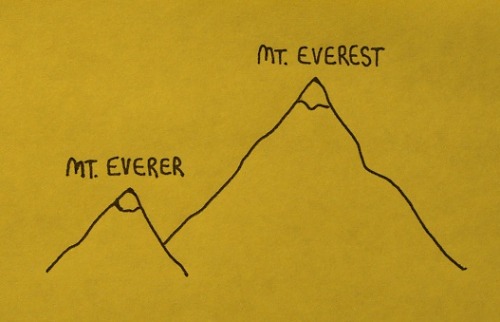
 "
"



















